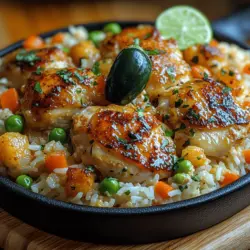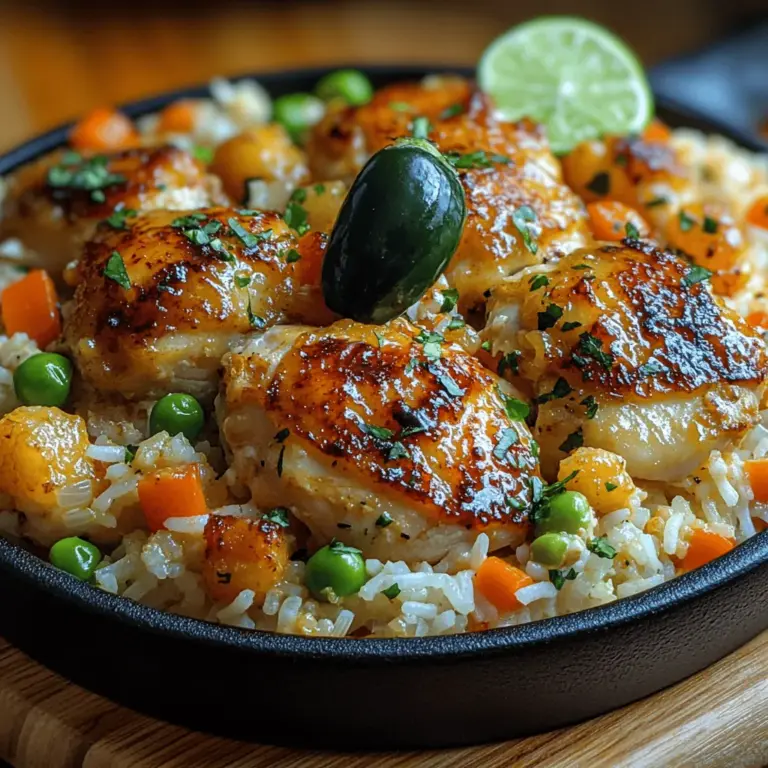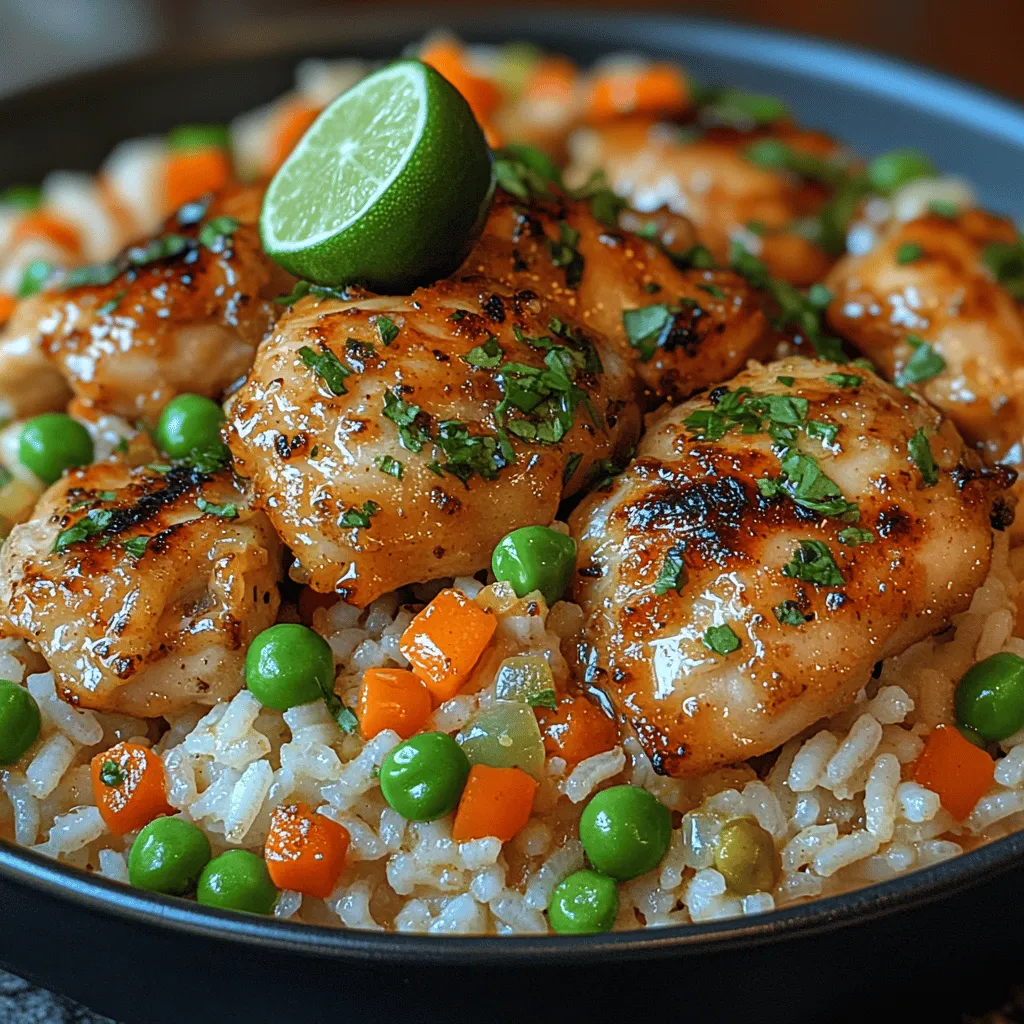The vibrant and flavorful Caribbean Chicken and Rice dish is a delightful way to bring a taste of the tropics to your dining table. This recipe combines tender chicken thighs with aromatic spices, creamy coconut milk, and fluffy rice, creating a hearty meal that’s both satisfying and easy to prepare. Perfect for family dinners or gatherings, this dish is not just about filling your stomach; it’s about experiencing the warmth and joy of Caribbean cuisine.
In this article, we will delve into the origins of this dish, its ingredients, and a step-by-step guide on how to prepare it, ensuring a delicious outcome every time.
Understanding Caribbean Cuisine
Exploring the Roots of Caribbean Cooking
Caribbean cuisine is a vibrant tapestry woven from a rich history of cultural influences. The islands’ culinary landscape has been shaped by Indigenous peoples, African slaves, European colonizers, and Asian immigrants, each contributing unique flavors and cooking techniques.
– Historical Influences: The Indigenous Taino and Arawak peoples laid the foundation with their use of cassava, sweet potatoes, and peppers. The arrival of African slaves introduced okra, yams, and a variety of cooking methods, particularly in the use of stews and one-pot meals. European colonizers brought spices, citrus fruits, and culinary practices that further enriched the islands’ diet. In more recent times, Asian immigrants have introduced ingredients like soy sauce and ginger, creating a fusion that is distinctly Caribbean.
– Unique Spices and Flavors: Caribbean dishes are characterized by their bold flavors and aromatic spices. Commonly used spices include allspice, thyme, and nutmeg, which add depth and warmth to dishes. The use of fresh herbs and local ingredients like scotch bonnet peppers, coconut, and tropical fruits creates a unique flavor profile that is both refreshing and satisfying.
The Significance of Chicken and Rice in Caribbean Culture
Among the many delightful dishes found in Caribbean cuisine, chicken and rice holds a special place.
– A Staple Dish Across the Islands: This dish is not just a meal; it’s a cultural symbol. It is often served during family gatherings, celebrations, and community events, reflecting the islanders’ hospitality and love for sharing food. Each island has its own version, utilizing local ingredients and spices, making it a versatile dish enjoyed by many.
– Variations in Preparation and Ingredients: While the basic elements of chicken and rice remain consistent, variations abound. Some might use pigeon peas, while others may incorporate various vegetables like bell peppers and carrots. The method of cooking can also differ, with some regions opting for a baked version while others prefer a stovetop preparation. These variations allow each cook to add a personal touch, making the dish their own.
Ingredients Breakdown
Essential Components of Caribbean Chicken and Rice
Creating a delicious Caribbean Chicken and Rice starts with understanding the key ingredients that make this dish exceptional.
– Chicken Thighs: For this recipe, bone-in and skin-on chicken thighs are recommended. The bone adds flavor and moisture to the meat, while the skin, when seared, creates a crispy texture that enhances the dish’s overall appeal. Chicken thighs are more forgiving than breasts, staying juicy even with longer cooking times.
– Rice Selection: Choosing the right type of rice is crucial for achieving the perfect texture. Long-grain varieties like jasmine or basmati work best for this recipe. They remain fluffy and separate when cooked, absorbing the aromatic flavors of the coconut milk and spices without becoming mushy.
The Role of Coconut Milk and Chicken Broth
– Creaminess and Depth of Flavor: Coconut milk is a hallmark of Caribbean cooking, adding a rich, creamy texture and subtle sweetness to the dish. When combined with chicken broth, it creates a flavorful cooking liquid that infuses the rice with aromatic notes, elevating the overall taste experience.
– Nutritional Benefits of Coconut Milk: Beyond flavor, coconut milk offers several nutritional benefits. It is rich in healthy fats, particularly medium-chain triglycerides (MCTs), which can provide a quick source of energy. Additionally, it contains vitamins and minerals like manganese and copper, contributing to a balanced meal.
Herbs and Spices: The Heart of the Recipe
No Caribbean dish is complete without a medley of herbs and spices that define its character.
– Understanding Allspice, Paprika, and Thyme: Allspice, often referred to as pimento, is a spice that imparts a warm, sweet flavor reminiscent of cinnamon, nutmeg, and cloves. Paprika adds a mild sweetness and vibrant color, while thyme brings an earthy, aromatic note to the dish, creating a harmonious balance of flavors.
– The Importance of Ginger and Garlic in Enhancing Flavor: Fresh ginger and garlic are essential for building a robust flavor profile. Ginger adds a touch of warmth and spice, while garlic provides depth and umami. Together, they create a fragrant base that enhances the overall taste of the chicken and rice.
The Spice Factor: Scotch Bonnet Pepper
– Origins and Flavor Profile of Scotch Bonnet: Scotch bonnet peppers are a staple in Caribbean cooking, known for their fruity flavor and intense heat. Hailing from the Caribbean, these vibrant peppers can range from sweet to fiery, making them a unique addition to many dishes.
– Adjusting Heat Levels to Suit Personal Preferences: If you’re sensitive to heat, you can adjust the amount of scotch bonnet used in the recipe. Removing the seeds and membranes will reduce the spiciness, allowing you to enjoy the pepper’s flavor without overwhelming heat. Alternatively, consider using a milder pepper if you’re serving guests with varying spice tolerances.
Preparation Steps
Marinating the Chicken for Maximum Flavor
One of the keys to achieving a flavorful Caribbean Chicken and Rice is the marination process.
– Importance of Marination Time: Allowing the chicken to marinate for at least 30 minutes (or even overnight) is crucial. This step allows the spices to penetrate the meat, ensuring that every bite is bursting with flavor.
– Tips for Seasoning and Enhancing Flavor: To create a marinade, combine the spices, garlic, ginger, and a splash of lime juice with the chicken. The acidity of the lime juice not only adds flavor but also helps to tenderize the meat. Ensure the chicken is well-coated and let it sit in the refrigerator, allowing the flavors to meld together beautifully.
Searing the Chicken: Techniques for Perfect Texture
Searing the chicken is the next step in preparing this delicious dish.
– Achieving a Golden-Brown Crust: Start by heating a large skillet over medium-high heat and adding a splash of oil. Once the oil is hot, carefully place the marinated chicken thighs skin-side down. Sear them until golden brown and crispy, about 5-7 minutes per side. This process locks in moisture and flavor, creating a delicious crust that adds texture to the dish.
– Utilizing Residual Flavors from the Chicken in the Cooking Process: After searing, remove the chicken from the skillet and set it aside. The flavorful bits left in the pan, known as fond, can be incorporated into the next steps of cooking. By sautéing the vegetables in the same skillet, you will capture those delicious flavors, adding depth to the dish.
Sautéing Vegetables: Building Layers of Flavor
With the chicken seared to perfection, it’s time to build on those flavors by sautéing the vegetables.
– Choosing the Right Vegetables: Common choices for this dish include onions, bell peppers, and carrots. These ingredients not only add color and texture but also contribute sweetness and crunch.
– Sautéing Techniques: In the same skillet used to sear the chicken, add a bit more oil if needed and toss in the chopped onions. Cook until translucent, then add the bell peppers and carrots. Sauté until the vegetables have softened slightly, about 3-5 minutes. This step ensures that the vegetables are well-cooked and fragrant, setting the stage for the rice to absorb all the delightful flavors.
By understanding the roots of Caribbean cuisine, breaking down the essential ingredients, and following these preparation steps, you are well on your way to creating a delicious Caribbean Chicken and Rice dish that will transport you to the tropical islands with every bite. In the next part of this article, we will explore the cooking process in detail, ensuring you achieve the perfect balance of flavors and textures for your Caribbean feast.
The Role of Onions and Bell Peppers
Onions and bell peppers play a vital role in Caribbean Chicken and Rice, contributing both flavor and texture to the dish. Onions, when sautéed, become sweet and aromatic, forming the foundational flavor base for the entire recipe. They release their natural sugars, which caramelize slightly during the cooking process, enhancing the overall depth of flavor.
Similarly, bell peppers add a colorful and crunchy element, with their natural sweetness balancing the savory notes of the chicken and spices. Traditionally, a mix of red and green bell peppers is used to provide visual appeal and a well-rounded flavor profile. These vegetables not only contribute to the dish’s taste but also provide essential vitamins, such as vitamin C and various antioxidants, making your meal healthier.
Timing for Optimal Texture and Taste
Proper timing in adding these vegetables is crucial; they should be sautéed until they are tender but not mushy. Typically, they should be added to the pan after the chicken has started to brown, allowing them to infuse their flavors into the meat while still retaining some of their crunch. This careful timing ensures that each ingredient shines through in the final dish, contributing to a balanced and harmonious flavor experience.
Toasting the Rice: Enhancing Flavor Profiles
Toasting the rice before cooking is an essential step that can elevate the flavor of your Caribbean Chicken and Rice significantly. This technique involves lightly browning the rice in a bit of oil or butter in the same pot where the dish is prepared.
Why Toasting Rice is Beneficial
Toasting the rice releases its natural oils and enhances its nutty flavor, which adds a unique depth to the dish. It also helps the grains maintain their shape during cooking, preventing them from becoming overly soft or mushy. This technique is particularly effective for long-grain varieties like basmati or jasmine rice, which are commonly used in Caribbean cuisine.
Techniques for Proper Rice Preparation
To properly toast the rice, use medium heat and stir it frequently to ensure even browning without burning. After about 3-5 minutes, when the rice is lightly golden and fragrant, it is ready for the next step. This simple yet effective method sets the stage for a rich flavor foundation in your dish.
Combining Ingredients: The Art of Layering Flavors
One of the keys to achieving a delicious Caribbean Chicken and Rice lies in the layering of flavors through the careful combination of ingredients.
The Importance of Liquid Ratios
Getting the liquid ratios right is crucial. For every cup of rice, you typically need about 1.5 to 2 cups of liquid. In this recipe, you can use a combination of chicken broth and coconut milk, which adds creaminess and richness, complementing the spices and chicken beautifully. Be mindful to adjust the amount of liquid based on the type of rice you are using, as different varieties absorb liquids differently.
How to Manage Cooking Times for Rice and Chicken
When combining the chicken and rice, you will want to consider the cooking times of both components. Chicken pieces generally require around 20-25 minutes to cook through, while rice will take approximately 15-20 minutes. To ensure everything is perfectly cooked, add the rice to the pot after the chicken has been browned and partly cooked. This timing allows the rice to absorb all the wonderful flavors from the chicken and spices while cooking.
Bringing It All Together: The Cooking Method
Understanding the cooking method and temperature control is essential for a successful Caribbean Chicken and Rice dish.
Understanding the Importance of Temperature Control
When it comes to cooking, maintaining the right temperature is key. Start by heating your pot over medium-high heat to brown the chicken, then reduce the heat to medium-low once you add the rice and liquids. This allows the rice to simmer gently, absorbing the flavors without becoming overcooked.
Covering the Pot for Steam Retention
Covering the pot is critical for steam retention, which helps cook the rice evenly and ensures that it becomes fluffy. A tight-fitting lid will trap moisture inside, allowing the rice to cook through without drying out. Let the mixture simmer undisturbed for about 15-20 minutes, then remove from heat and allow it to rest for an additional 5-10 minutes with the lid on. This resting period helps to further enhance the texture of the rice.
Adding Vegetables at the Right Time
Timing is also essential when it comes to adding vegetables like peas and carrots.
Why Timing Matters for Peas and Carrots
These vegetables should be added towards the end of the cooking process; this ensures they remain vibrant and crisp, providing a nice contrast to the soft rice and chicken. If added too early, they can become overcooked and lose their color and nutritional value.
Enhancing Nutrition and Color in the Dish
Adding peas and carrots not only enhances the nutrition of your meal with added fiber and vitamins but also contributes to the visual appeal of the dish. Their bright colors stand out against the golden rice, making the dish more inviting.
Finishing Touches: Fluffing the Rice and Garnishing
Once the cooking is complete, it’s time for the finishing touches that will elevate your dish to perfection.
Techniques for Perfect Rice Texture
To achieve fluffy rice, use a fork to gently fluff the grains once you remove the pot from heat. This step helps separate the grains, allowing steam to escape and preventing clumping. Be cautious not to stir too vigorously, as this can break the rice and lead to a mushy texture.
The Role of Garnishes in Presentation and Flavor
Garnishing your dish is not just about aesthetics; it also adds layers of flavor. A sprinkle of fresh cilantro, green onions, or parsley can brighten the dish and provide a fresh contrast to the rich, comforting flavors of the chicken and rice. Additionally, consider adding a few slices of fresh chili for those who enjoy a bit of heat.
Serving Suggestions
When it comes to serving your Caribbean Chicken and Rice, presentation can make a significant difference in the dining experience.
Tips for an Aesthetically Pleasing Presentation
For an eye-catching presentation, serve the chicken pieces nestled on a bed of rice, garnished with fresh herbs and colorful vegetables. Use a large serving platter or individual bowls to create a more inviting appeal. You can also add lime wedges on the side for an additional touch of color and flavor.
Ideas for Side Dishes and Accompaniments
Pair your Caribbean Chicken and Rice with side dishes that complement its flavors. A simple green salad with a tangy vinaigrette, fried plantains, or a refreshing cucumber salad can enhance the meal. Additionally, consider serving a cool, tropical fruit salad for a sweet finish.
Enhancing Flavor with Lime Wedges
Lime wedges can be a game-changer when served alongside your dish.
The Balance of Acidity in the Dish
The acidity from lime juice balances the richness of the coconut milk and chicken, brightening the overall flavor profile. Encourage your guests to squeeze fresh lime juice over their servings before digging in, as it adds a zesty kick that enhances the dish’s tropical essence.
Serving Suggestions for a Complete Meal Experience
For a complete meal experience, serve your Caribbean Chicken and Rice with a refreshing drink such as iced tea or a tropical fruit punch. This not only complements the flavors of the dish but also immerses your diners in the vibrant Caribbean culture.
Nutritional Information
Understanding the nutritional benefits of your Caribbean Chicken and Rice can enhance your appreciation for this dish.
Breakdown of Calories, Proteins, Fats, and Carbohydrates
A typical serving of Caribbean Chicken and Rice contains approximately 450-500 calories, 25-30 grams of protein, 10-15 grams of fat, and 60-65 grams of carbohydrates. The exact nutritional values may vary based on the specific ingredients and portion sizes used.
Health Benefits of Key Ingredients Like Chicken and Coconut Milk
Chicken is an excellent source of lean protein, essential for muscle building and repair. Coconut milk, while higher in fat, provides medium-chain triglycerides (MCTs) that can promote healthy metabolism. Additionally, the vegetables contribute essential vitamins and minerals, making this dish a well-rounded meal option.
Conclusion
Caribbean Chicken and Rice is more than just a meal; it embodies the essence of Caribbean culture and cuisine. Its rich flavors, vibrant colors, and comforting textures create an experience that is as delightful to prepare as it is to enjoy. By following the steps outlined in this article, you can create a satisfying meal that transports your taste buds straight to the islands. With the proper techniques and a little patience, you can bring the spirit of the Caribbean into your kitchen. Enjoy the journey of cooking and the joy of sharing this flavorful dish with your loved ones.



